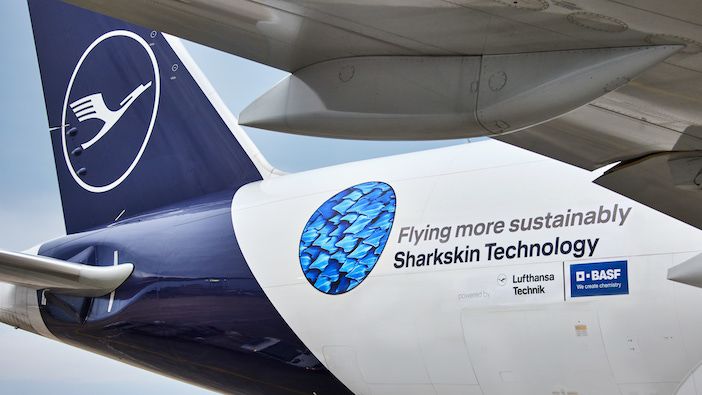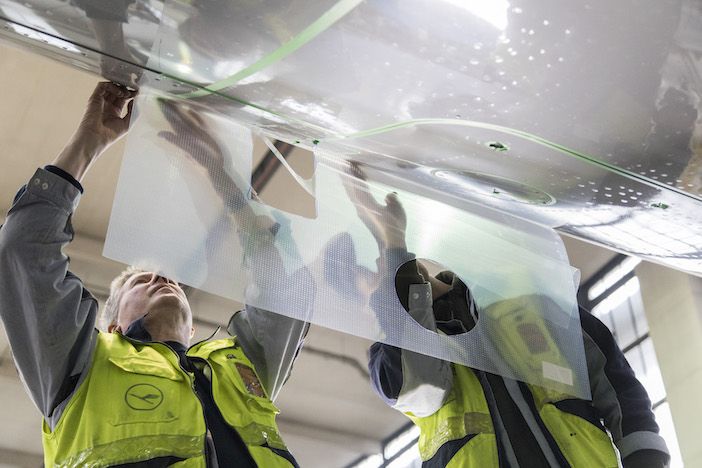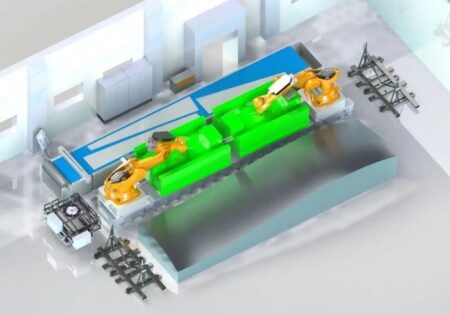Lufthansa is covering its fleet of Boeing 777F cargo aircraft with a film that mimics the fine structure of shark skin to make them more aerodynamic and save fuel, after the new material’s performance was validated through 1,500 hours of flight testing.
The surface film, which has been developed in partnership with chemicals company BASF as part of a project called AeroShark will be be rolled out on Lufthansa Cargo’s entire freighter fleet from the beginning of 2022.
The film’s surface structure consists of riblets that measure around 50 micrometers, imitating the properties of shark skin and optimizing the aerodynamic flow of the aircraft to produce a drag reduction and reduce fuel consumption.
For Lufthansa Cargo’s 10 Boeing 777F freighters, Lufthansa Technik estimates a drag reduction of more than one percent. The company predicts use of the material will result in annual savings of around 3,700 tons of kerosene and just under 11,700 tons of carbon dioxide emissions, the equivalent of 48 individual freight flights from Frankfurt to Shanghai.
Dr. Johannes Bussmann, CEO of Lufthansa Technik AG said, “I am very proud that we will soon be able to transfer the positive findings of the validation phase into the series application with Lufthansa Cargo. The extremely constructive collaboration with BASF is also the best example of cross-sector cooperation in the interest of the sustainability of the aviation industry.”
Lufthansa Technik is working to obtain a Supplemental Type Certificate (STC) for the use of the shark skin material 777F from the European Union Aviation Safety Agency (EASA), which is required for operation.
BASF and Lufthansa have developed the shark skin material to withstand strong UV radiation as well as temperature and pressure fluctuations at high altitudes during flight, as well as extreme durability and weather resistance. The material has also been designed to be simple to apply, handle and repair.

The aviation industry has been researching the use of riblet surfaces such as shark skin for many years. Other research programs are looking at fish scales and owl feathers to optimize aerodynamic drag.
At the end of 2019, Lufthansa Technik and BASF fitted almost the entire lower half of a Lufthansa Boeing 747-400’s fuselage with 500 square meters of the shark skin material and had this modification certified by EASA. This aircraft (registration D-ABTK) validated the savings potential of the shark skin on scheduled long-haul services during more than 1,500 flight hours, with reduced emissions of around 0.8%.
The savings for the Boeing 777F are estimated to be even higher, because the application areas are larger in this case due to the absence of window rows on a freighter. The savings are validated using a software for fuel consumption analyses developed by Lufthansa Technik, which allows the effectiveness of a wide variety of different aircraft modifications to be demonstrated reliably based on comprehensive data.
Lufthansa Technik and BASF intend to continue developing the new technology consistently to include additional aircraft types and larger surfaces so that they can support airlines around the globe even more comprehensively in the future in reaching their sustainability goals.
According to modeling done by the companies, the use of shark skin technology at its highest expansion level could reduce carbon dioxide emissions of an aircraft by as much as three percent.
Dorothea von Boxberg, CEO of Lufthansa Cargo said, “We are proud that we will now be able to operate our entire freighter fleet even more efficiently in the future thanks to the shark skin technology and reduce the carbon footprint of our modern fleet further. The investments we have made in rolling out AeroSHARK at Lufthansa Cargo consciously reaffirm our commitment to the United Nation’s sustainable development goal on climate action.”





